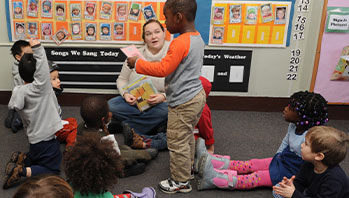MA Standards:
English Language Arts/Foundational Skills/RF.PK.MA.2.c: Identify the initial sound of a spoken word and, with guidance and support, generate several other words that have the same initial sound.
Head Start Outcomes:
Language Development/Receptive Language: Attends to language during conversations, songs, stories, or other learning experiences.
Literacy Knowledge/Phonological Awareness: Identifies and discriminates between sounds and phonemes in language, such as attention to beginning and ending sounds of words and recognition that different words begin or end with the same sound.
PreK Learning Guidelines:
English Language Arts/Reading and Literature 8: Listen to, identify, and manipulate language sounds to develop auditory discrimination and phonemic awareness.
Word Play: Hopping Syllables #1

© Commonwealth of Massachusetts, Department of Early Education and Care (Jennifer Waddell photographer). All rights reserved.
ELA Focus Skills: Phonological Awareness (Segmenting), Vocabulary
Introduce the activity by asking children to remember how they clap and count the parts of children’s names during the greeting song. Explain that now you want them to hop once for each part of a flower name.
- Demonstrate how to play the game with a one-syllable flower name. Say rose and hop once. Repeat the word and raise one finger to indicate one word part.
- Repeat the process with a two-syllable flower name, such as tu-lip, or dai-sy. Hop as you say each syllable: tu-lip. Ask, How many times did I hop? Two times. Hold up two fingers. The word tu-lip has two parts. Now you try. Have children say the word tu-lip as they hop for each word part.
- Repeat the process with three- and four-syllable flower names such as daff-o-dil and ger-a-ni-um.
- Invite children to suggest the names of other flowers they know. Let the child who suggests a flower lead the group in hopping the syllables.
Adaptation: If very young children have trouble hopping, have them stamp one foot to the rhythm.
